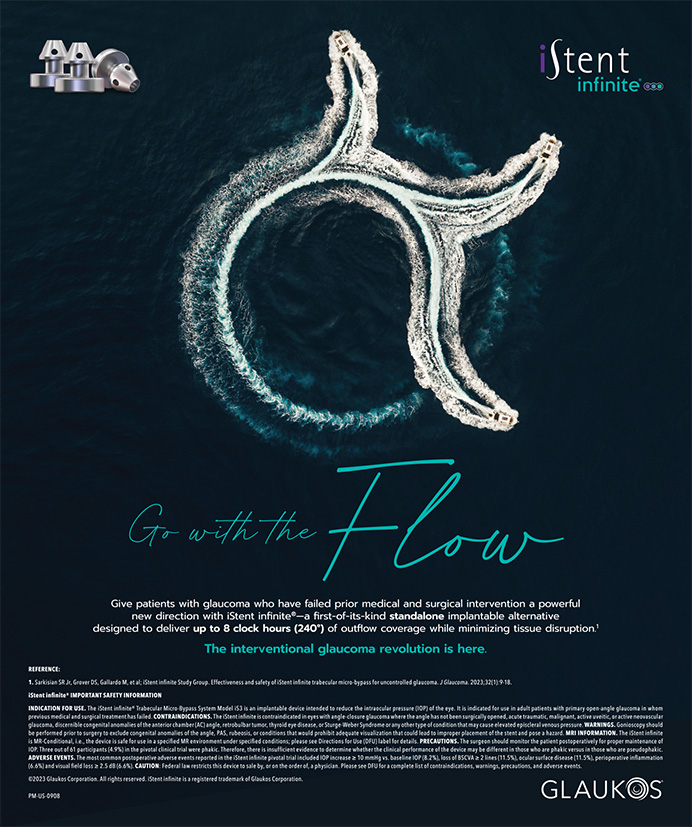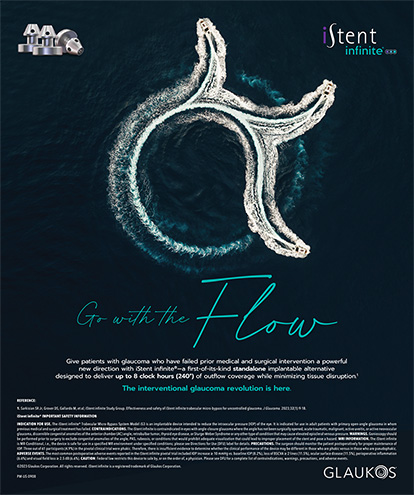CASE PRESENTATION
A 34-year-old male presented for a refractive surgery evaluation. He was deemed an excellent candidate for LASIK based on a complete workup, including refraction, topography, an evaluation with the Pentacam Comprehensive Eye Scanner (Oculus, Inc., Lynnwood, WA), and an ocular examination. His preoperative refractive error was -6.00 D OD and -6.25 D sphere OS. Central corneal pachymetry measured 534 µm OU by ultrasound (Figure 1).
The surgeon planned a -6.00 D treatment for both eyes and programmed a Visx Star S4 laser (Advanced Medical Optics, Inc., Santa Ana, CA) for conventional bilateral LASIK. The ablation began on the patient's right eye after the uncomplicated creation of 75-µm-thick flap. Approximately 60 of the way through the ablation, the surgeon realized that the process was taking longer than expected. In addition, he noted that the fluorescence pattern of the ablation was in the peripheral cornea. The procedure was stopped. Upon close inspection of the entered parameters on the laser, the surgeon saw that 6.00 D had been inadvertently programmed for both eyes instead of -6.00 D. He aborted the original procedure after 568 of 968 pulses had been delivered to the peripheral cornea of the patient's right eye.
The surgeon replaced the flap and reprogrammed the laser for the correct parameters for the patient's right eye. Then, he lifted the flap and proceeded to perform an ablation of -6.00 D. The left eye's flap and ablation were completed uneventfully.
On the first postoperative day, the patient had UCVAs of 20/counts fingers in his right eye and 20/25 OS. The refraction in his right eye was -4.50 1.50 X35 = 20/20. The central corneal pachymetry was 440 µm. Figure 2 provides the topography, and Figure 3 shows the difference map.
At 1 week, the patient's refraction was -3.50 1.00 X78 = 20/15 in his right eye. Figure 4 shows an evaluation with the Pentacam.
How would you have proceeded upon recognizing the programming error, and how would you approach the visual rehabilitation of the patient's right eye?
STEVEN J. DELL, MD
Although things are bad, they could have been worse. For example, a planned 3.00 D treatment incorrectly executed as -3.00 D would be much tougher to address. In this case, the right cornea has a relatively bizarre residual shape from the removal of central and midperipheral tissue. Positive spherical aberration is present and is combined with the unusual situation of a peripheral trough of removed tissue, resulting in a midperipheral area of relative elevation, as shown on the anterior float map of the Pentacam.
Although one often desires to correct iatrogenic situations such as this one quickly, the stability of the refractive outcome should be established, which could take months. The patient could use a soft contact lens in the interim to deal with his anisometropia. The thinnest central postoperative pachymetry reading was obtained with ultrasound. Using this worst-case scenario of 440 µm, a 75-µm flap would leave 388 µm of residual central stroma. The Pentacam's pachymetric data also indicate sufficient peripheral stroma to allow an enhancement.
Regardless of whatever method was used to create the flap, I would feel more comfortable performing surface ablation. If the surgeon used a femtosecond laser for the original procedure, a 15-µm deviation in the flap's thickness is still possible, which could mean that the flap is very near Bowman's membrane. Even if this flap is exactly 75 µm, one should recognize that approximately 60 of its 75 µm are epithelium and Bowman's membrane. The limits in the accuracy of subtraction pachymetry give me little confidence that this flap is sufficiently thick to be lifted safely. The flap's diameter is not stated. With the unplanned hyperopic ablation, however, this eye has probably received peripheral epithelial ablation. In my hands, it would be associated with an increased risk of epithelial ingrowth with relifting, probably due to the photoactivation of these epithelial cells.
If reliable wavefront maps could be obtained, I would perform a wavefront-driven enhancement followed by an application of mitomycin C 0.02 for 20 seconds. I would carefully ensure that the planned ablation depth made sense given the refractive error involved.
JOHN F. DOANE, MD
This patient has had quite a refractive experience. Originally a -6.00 D myope, he had an approximately 3.60 D ablation followed sequentially by a -6.00 D ablation. When his refraction stabilizes, I would expect it to be approximately -3.50 D. At 1 week postoperatively, the eye's spherical equivalent, not by chance, is -3.00 D. The math is holding up thus far. The residual stromal bed at present for this patient is 534 µm - 75 µm (flap) - 84 µm (6.00 D X14 µm per diopter [liberally]) = 375 µm. The residual stromal bed is on target, as the pachymetry measurement 1 day postoperatively was 440 µm (the flap is 75 µm, and the residual stromal bed was 375 µm [ie, 450 µm is quite close]).
It is highly unlikely that this patient will have any structural instability of the cornea despite the inadvertent error. If he were averse to further surgery, a soft contact lens would be the best option for refractive correction and treating the asthenopic symptoms likely occurring from the 3.00 D of anisometropia. If he were accepting of further corrective eye surgery, I would recommend either LASIK or PRK 3 months postoperatively. Importantly, I would wait for refractive stability to occur, around 8 to 12 weeks postoperatively at the earliest.
LOUIS E. PROBST, MD
I would not have reversed the laser treatment of the patient's right eye or treated his left eye. Rather, I would have stopped and explained the problem to the patient (see Admitting an Error). I would closely monitor the refractive outcome for his right eye and see the patient frequently in order to build a strong relationship. Once his refraction stabilized, I would perform a customized enhancement on his right eye at no charge. After achieving a satisfactory correction, I would discuss a LASIK procedure for the patient's left eye with him.
The surgeon in this case has been lucky. The patient's myopic outcome is correctable to 20/15 at 1 week. Because I use the Orbscan topographer (Bausch & Lomb, Rochester, NY) rather than the Pentacam, I am less familiar with the maps shown in Figures 1 to 4, but they do not seem to demonstrate any major problems. Until the refraction in the patient's right eye fully stabilized in approximately 6 months, I would have him wear a soft contact lens.
Based on the case presentation, this patient would likely achieve an excellent result with a customized PRK enhancement for the residual refractive error. I would not perform a LASIK enhancement, because there is insufficient tissue in the stromal bed and there has already been an enormous amount of peripheral and central ablation. For the customized PRK enhancement, I would remove the epithelium with alcohol to avoid disturbing the flap. I would carefully evaluate the depth of the treatment in an effort to avoid having the ablation go through the flap. The depth could be decreased by reducing the optical zone of the customized treatment to as low as 5.5 mm. After the ablation, I would apply mitomycin C to prevent haze.
Section editors Karl G. Stonecipher, MD, and Parag A. Majmudar, MD, are cornea and refractive surgery specialists. Dr. Stonecipher is Director of Refractive Surgery at TLC in Greensboro, North Carolina. Dr. Majmudar is Associate Professor, Cornea Service, Rush University Medical Center, Chicago Cornea Consultants, Ltd. They may be reached at (847) 882-5900; pamajmudar@chicagocornea.com.
Steven J. Dell, MD, is Director of Refractive and Corneal Surgery at Texan Eye Care in Austin. He is a consultant to Advanced Medical Optics, Inc., Allergan, Inc., and Eyeonics, Inc. Dr. Dell may be reached at (512) 327-7000.
John F. Doane, MD, is in private practice with Discover Vision Centers in Kansas City, Missouri, and is Clinical Assistant Professor for the Department of Ophthalmology, Kansas University Medical Center in Kansas City. He acknowledged no financial interest in the products or companies mentioned herein. Dr. Doane may be reached at (816) 478-1230; jdoane@discovervision.com.
Louis E. Probst, MD, is Medical Director of TLC The Laser Eye Centers in Chicago, Madison, and Greenville, Illinois. He is a consultant to Advanced Medical Optics, Inc., and TLCVision. Dr. Probst may be reached at (708) 562-2020.


